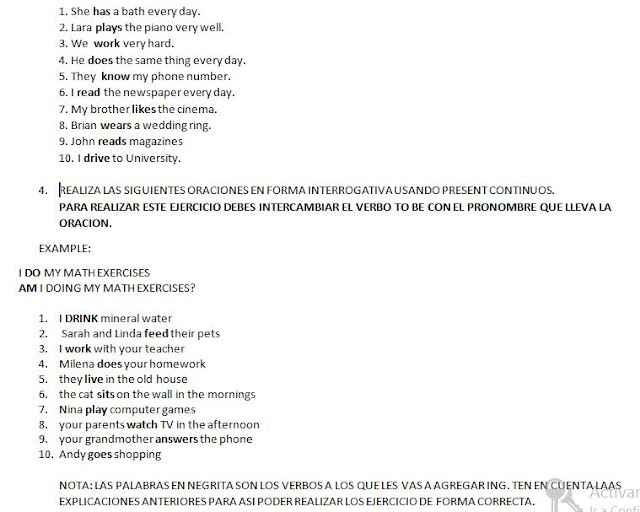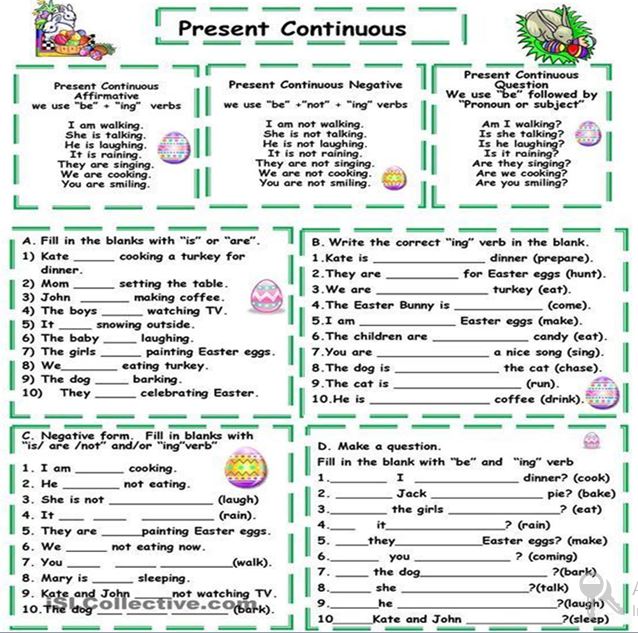INGLÉS
INSTITUCION EDUCATIVA DE YATI
PLANEACION DE CLASES NO PRESENCIALES
DOCENTE: ADRIANA BOLIVAR FLOREZ AREA: INGLES GRADO: 7º
FECHA DE INICIO: 3 DE NOVIEMBRE DE 2020
FECHA DE ENTREGA: 20 DE NOVIEMBREDE 2020
CELULAR: 3234562919
E-MAIL: adrianabolivar1975mail.com
TEMA: READING COMPREHENSION
CHECK YOUR UNDERSTANDING
A LOST
DOG
ARE THE
SENTENCES TRUE OR FALSE?
1. The dog
is lost.
2. The
dog's name is Sherry.
True False
3. The dog
is a female.
True False
4. The dog
was lost on Monday morning.
True False
5. The dog
was lost in Central Park.
True False
6. There
is a reward for finding the dog.
True False
COMPLETE THE LOST DOG REPORT.
· Name ________________
·
Age: ______________
·
Date dog was lost: __________________
·
Time dog was lost: _______________
·
Place dog was lost: _________
·
Money offered for finding dog: _________ euros.
DISCUSSION:
RESPONDE LAS SIGUIENTES PREGUNTAS
1. DO YOU HAVE A PET?
2. WHAT IS ITS NAME?
3. HOW LONG DO YOU HAVE YOUR
PET?
ACTIVIDAD Nº 2
AT THE
RESTAURANT
DESCRIBE QUE ESTAN HACIENDO ESTAS PERSONAS. ESCRIBE UN TEXTO CORTO EN INGLES.
AT THE RESTAURANT
PUT THE FOOD INTO THE CORRECT GROUP
DISCUSSION: RESPONDE LAS SIGUIENTE PREGUNTAS
1.
WHAT
FOOD DO YOU LIKE IN THIS MENU?
2.
WHAT
FOOD DON`T LIKE IN THIS MENU?
3.
WHAT
WOULD YOU LIKE TO EAT IN THE RESTAURNT?
INSTITUCION EDUCATIVA DE YATI
PLANEACIÓN DE CLASES NO PRESENCIALES
DOCENTE: ADRIANA BOLIVAR FLOREZ AREA: INGLES GRADO: 7º
FECHA DE INICIO: SEPTIEMBRE 14 DE 2020 FECHA DE ENTREGA: OCTUBRE 2 DE 2020
CELULAR: 3234562919 E-MAIL: adrianabolivar1975mail.com
TEMA: DAILY ROUTINES PRESENT SIMPLE
GUIA Nª 1 CUARTO PERIODO
NOMBRE: _________________________________________GRADO:_____ FECHA: _________
EN ESTA ACTIVIDAD VAMOS A TRABAJAR DAILY ROUTINES… EN TIEMPO PRESENTE SIMPLE. TRABAJAREMOS CON LA RUTINA DIARIA DE EMMA Y DE ACUERDO A ESTA LECTURA REALIZAREMOS LOS SIGUIENTES EJERCICIOS.
INSTITUCION EDUCATIVA DE YATI
PLANEACIÓN DE CLASES NO
PRESENCIALES
DOCENTE:
ADRIANA BOLIVAR FLOREZ AREA:
INGLES GRADO: 7º
FECHA DE INICIO:
SEPTIEMBRE 14 DE 2020 FECHA DE ENTREGA: OCTUBRE 2 DE 2020
CELULAR:
3234562919 E-MAIL:
adrianabolivar1975mail.com
TEMA:
VOCABULARY
GUIA Nª 4
TERCER PERIODO
NOMBRE:
_________________________________________GRADO:_____ FECHA:
_________
EN ESTAS GUIA Nº 4 DEL TERCER PERIODO VAMOS A TRABAJAR VOCABULARY. UN VOCABULARIO FACIL DE REALIZAR Y DE COMPRENDER. RELACIONADOS CON TEMAS QUE YA HEMOS VISTO.
MEANS OF TRANPORTATION
EN ESTAS GUIA Nº 4 DEL TERCER PERIODO VAMOS A TRABAJAR VOCABULARY. UN VOCABULARIO FACIL DE REALIZAR Y DE COMPRENDER. RELACIONADOS CON TEMAS QUE YA HEMOS VISTO.
EN ESTAS GUIA Nº 4 DEL TERCER PERIODO VAMOS A TRABAJAR
VOCABULARY. UN VOCABULARIO FACIL DE REALIZAR Y DE COMPRENDER. RELACIONADOS CON
TEMAS QUE YA HEMOS VISTO.
BEDROOMS
VOCABULARY
EN ESTAS GUIA Nº 4 DEL TERCER PERIODO VAMOS A TRABAJAR
VOCABULARY. UN VOCABULARIO FACIL DE REALIZAR Y DE COMPRENDER. RELACIONADOS CON
TEMAS QUE YA HEMOS VISTO.
FOOD
AND DRINKS
INSTITUCION EDUCATIVA DE YATI
DOCENTE: ADRIANA BOLIVAR FLOREZ AREA: INGLES GRADO: 7º
FECHA DE INICIO: JULIO DE 2020 FECHA DE ENTREGA: JULIO DE 2020
CELULAR: 3234562919 E-MAIL: adrianabolivar1975mail.com
TEMA: IMPERATIVES
GUIA Nª 3 TERCER PERIODO
NOMBRE: ___________________________________________GRADO:_________ FECHA: _____________
IMPERATIVES:
IMPERATIVOS
Al
igual que en español, el modo imperativo en inglés se usa generalmente para
transmitir una orden, inducir a alguien a hacer algo, para hacer
una advertencia o para dar instrucciones.
En
inglés podemos distinguir varias formas de imperativo: afirmativo, negativo y
exhortativo, así como otras formas más cordiales de expresar una orden. Veamos
juntos las características de cada una de ellas.
|
IMPERATIVO AFIRMATIVO |
IMPERATIVO NEGATIVO |
IMPERATIVO EXHORTATIVO |
IMPERATIVO PARA DAR UNA SUGERENCIA |
IMPERATIVO + PRONOMBRE PERSONAL |
|
Es la forma más común y directa del imperativo.
Únicamente tiene la segunda persona en singular y plural. Se forma con el infinitivo
del verbo sin el “to“. Hurry up or you’ll miss the show!
(¡Date prisa o te perderás el espectáculo!) Switch the TV off.
Put the flour, milk, and eggs in a bowl
and whisk until smooth. Dado que es una forma muy directa de dar órdenes,
se puede acompañar con algunas expresiones como just (solamente), please (por
favor), if you don’t mind (si no te
importa) etc., para suavizar el tono. Just wait for me here, please.
Close the door, if you wouldn’t mind. |
Es la forma negativa del imperativo afirmativo y
requiere la adición de los auxiliares do + not(don’t en la forma contraída) al infinitivo del
verbo sin el “to“. Don’t be late! Do not go to work today. |
Más que un imperativo, el imperativo exhortativo
es una exhortación y solo aplica a la primera persona plural. En algunos
casos, va acompañado de please (por
favor). Se forma con el prefijo Let’s + el
infinitivo del verbo sin “to” en forma
afirmativa. Let us
observe a minute of
silence, please. En la forma negativa, requiere la adición de
la negación not entre el prefijo y el verbo. Let’s not go
in, please. Cuando el prefijo Let va
seguido de un pronombre personal diferente de us,
toma el significado de dejar, permitir. Let me do the washing up for once. |
En algunos casos, la forma imperativa se utiliza
para hacer una sugerencia o hacer una propuesta. En estos casos podemos tener
dos construcciones: ·
Let’s + verbo en infinitivo sin el
“to” (Imperativo exhortativo) Let’s not
miss the train. Let’s take a holiday! ·
Why don’t we + verbo en
infinitivo sin el “to“ Why don’t we
go to the beach? Why don’t you
tell her the truth? |
En algunos casos, el pronombre personal se puede
agregar para reforzar el valor imperativo. Pero ten cuidado de no parecer
poco cortés. Esta forma verbal se usa solo en casos de una orden fuerte y decisiva. Can I go
home? (¿Puedo irme a casa? Don’t you
tell me what to do! |
|
IMPERATIVO DIRIGIDO A UN GRUPO DE PERSONAS |
||||
|
En algunas situaciones nos dirigimos a un grupo
bien definido de personas. En ese caso, se pueden usar palabras como somebody (alguien), everybody (todos), all (todos). Somebody call an ambulance. Quick! Everybody sit
down, please. All rise! (used in courtrooms) |
IMPERATIVO + DO |
|||
|
En algunos casos, se puede agregar el
auxiliar Do para darle una apariencia
más formal y gentil al imperativo. Do come in! Do come and visit us next time. Do help yourselves to the buffet! |
A continuación encontrarás las reglas
de un museo.
Completa el texto usando los siguientes verbos en afirmativo (Close the window
/ Cierra la ventana) o
negativo (Do
not close he window / No cierres la ventana) según c
No debes usar contracciones para la forma negativa (Escribe “Do not” en vez de “Don’t”).
Estos son los verbos que debes usar:
o
Smoke: fumar
o
Bring: traer
o
Eat: comer
o
Throw: arrojar
o
Touch: tocar
o
Turn off: apagar (un dispositivo electrónico)
o
Enjoy: disfrutar1
Welcome to the City Museum. Before we start our tour, we’d like to inform you about the rules of the museum. For safety reasons, please respect the following rules:
§ 1. Do not take pictures with flash.
§ 2. Ask as many questions as you can.
§ 3. Please _________ or drink inside the museum.
§ 4. _________ your visit as much as possible.
§ 5. _________ your mobile phone during your visit.
§ 6. _________ the items on display as they can break.
§ 7. _________ inside the museum – Cigarettes are bad for your health.
§ 8. _________ garbage on the floor.
§ 9. _________ umbrellas or large packages to the museum.
We hope you enjoy your visit to the City Museum. Come back soon.
1. Traduce al inglés las siguientes oraciones. Usando la forma imperativa.
2) Vayamos al cine
3) No te ensucies
4) No invites a tu amigo a mi fiesta
5) Juguemos al tenis
6) Ellos deben comprar un ticket para entrar en este club
7) Ella debe ordenar su habitación
8) Preparemos la cena
9) Él debe reparar mi bicicleta
10) No digas eso
11) Ella debe descansar en la cama
12) Ellos no deben aceptar esa excusa
13) Lávate las manos
14) No hagamos tanto ruido
15) Cómprame el periódico
16) Él debe parar de fumar en este edificio
17) Ellos no deben nadar en el lago
18) No continuemos discutiendo
19) Lavemos el coche
20) Ellos no deben trabajar durante la huelga
EN ESTE EJERCICIO VAS A COMPLETAR LAS ORACIONES CON LOS VERBOS QUE ESTAN EN EL CUADRO A TU DERECHA, TENIENDO EN CUENTA LAS IMÁGENES.
 |
| PUNTO A: RELACIONA LAS IMÁGENES CON LAS ORACIONES DE LA DERECHA. ENEUMERALAS EN LOS CIRCULOS QUE ESTAN CON LAS IMÁGENES |
PUNTO B: COMPLETE LAS ORACIONES CON LOS IMPERATIVOS
SUGERIDOS
PUNTO C. ESCRIBE EL IMPERATIVO OPUESTO EN INGLES
PUNTO D. ESCRIBE LAS INSTRUCCIONES PARA CADA SITUACION UTILIZANDO LOS VERBOS SUGERIDOS.
SEGUNDA GUÍA DE TRABAJO - TERCER PERÍODO






































Comentarios
Publicar un comentario